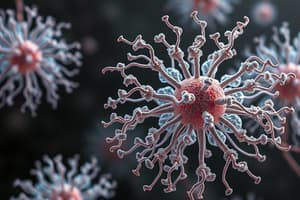Podcast
Questions and Answers
What is the function of ribosomes in a cell?
What is the function of ribosomes in a cell?
- Facilitate movement within the cell
- Synthesize proteins (correct)
- Store genetic material
- Maintain cell shape
Which organelle is described as a 'nano-machine' for protein synthesis?
Which organelle is described as a 'nano-machine' for protein synthesis?
- Ribosomes (correct)
- Plasma membrane
- Nucleus
- Mitochondria
What is the primary function of a plasmid in prokaryotic cells?
What is the primary function of a plasmid in prokaryotic cells?
- Provide energy for the cell
- Synthesize proteins
- Facilitate cell division
- Carry non-essential properties like antibiotic resistance (correct)
Which region of the cell is described as containing the primary DNA and being the main center for DNA transcription and replication?
Which region of the cell is described as containing the primary DNA and being the main center for DNA transcription and replication?
What is the function of the cytoplasm in a eukaryotic cell?
What is the function of the cytoplasm in a eukaryotic cell?
Which structure in a prokaryotic cell allows for the attachment to animal or plant tissues?
Which structure in a prokaryotic cell allows for the attachment to animal or plant tissues?
What is the main function of the cell wall?
What is the main function of the cell wall?
Where are ribosomes primarily located in the cell to produce proteins?
Where are ribosomes primarily located in the cell to produce proteins?
Which organelle is responsible for producing lipids for membrane formation?
Which organelle is responsible for producing lipids for membrane formation?
What type of filaments are the smallest in the cytoskeleton and made of actin protein?
What type of filaments are the smallest in the cytoskeleton and made of actin protein?
What is the function of the centrosome in a cell?
What is the function of the centrosome in a cell?
Which protein forms microtubules, the largest filaments in the cytoskeleton?
Which protein forms microtubules, the largest filaments in the cytoskeleton?
What is the function of the cell membrane?
What is the function of the cell membrane?
Which organelle is embedded in the cytoplasm?
Which organelle is embedded in the cytoplasm?
What is the composition of cytoplasm?
What is the composition of cytoplasm?
What is the function of plasmid in a cell?
What is the function of plasmid in a cell?
Which part of the cell is derived from the Greek word 'karyon' meaning 'before the nucleus'?
Which part of the cell is derived from the Greek word 'karyon' meaning 'before the nucleus'?
What is the outermost layer responsible for protecting bacteria from dryness and helping it attach to other organisms called?
What is the outermost layer responsible for protecting bacteria from dryness and helping it attach to other organisms called?
Study Notes
Prokaryotic Cells
- Have a lot of ribosomes, which translate genetic code into proteins
- Contain plasmid DNA, which carries non-essential properties like antibiotic resistance
- Have a nucleoid, a thin, transparent region that contains primary DNA, where DNA transcription and replication occur
- Have pili (pilus), fine, hair-shaped structures that facilitate genetic material exchange during mating and attachment to animal/plant tissues
- Have flagella, whip-like structures that enable cell movement
Eukaryotic Cells
- More complex than prokaryotes
- Characterized by a membrane-bound nucleus
- Include animal, plant, fungal, and algal cells
- Contain membrane-bound organelles like the nucleus, mitochondria, and endoplasmic reticulum
Nucleus
- The "brain" of the cell, holding most of the cell's genetic material
- Organized into chromosomes within the nucleus
- Surrounded by a bilayer nuclear membrane (nuclear envelope) with nuclear pores
- Houses the nucleolus, the largest structure in the nucleus
Cytoplasm
- Gel-like substance containing membrane-bound organelles
- Composed of water, dissolved substances, and structural proteins
- Makes up about 70% of the cell's volume
Plasma Membrane
- Major component: a phospholipid bilayer
- Regulates substance traffic in and out of cells
Cytoskeleton
- Provides cellular support and shape maintenance
- Composed of microtubules (largest filaments), intermediate filaments, and microfilaments
- Made of proteins like tubulin, keratin, and actin
Centrosome
- Functions as the main microtubule organizing center (MTOC)
- Plays a crucial role in mitosis, and defects are linked to cell growth diseases like cancer
- Found only in animal cells
Cell Wall
- Rigid structure maintaining the cell's shape
- Generally made of polysaccharides and structural proteins for support
Endoplasmic Reticulum
- The manufacturer, producing substances for cell growth
- Consists of Rough Endoplasmic Reticulum (RER) and Smooth Endoplasmic Reticulum (SER)
- RER has ribosomes, which produce proteins, while SER helps produce lipids
Studying That Suits You
Use AI to generate personalized quizzes and flashcards to suit your learning preferences.
Description
Test your knowledge on key components of prokaryotic cells such as ribosomes, plasmids, and nucleoid. Learn about the functions and characteristics of these structures in protein synthesis, genetic properties, and DNA organization.




